Traditions come and go. Sometimes they even come back. When I was very young, the Halloween tradition of trick-or-treating was abandoned, owing to possibly spurious rumors of poisoned candy or razor blades in apples. Then as I got older, the tradition started to come back—tepidly at first, with strange enablers like the local hospitals, opening up their radiology departments so that worried parents could x-ray suspect treats. Before long trick-or-treating (or 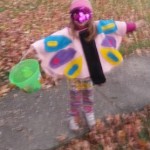 Beggars’ Night, to some of our older neighbors) was firmly re-ensconced. Kids today, not to mention their older sibs and even their aunts and uncles, probably couldn’t imagine Halloween without it.
Beggars’ Night, to some of our older neighbors) was firmly re-ensconced. Kids today, not to mention their older sibs and even their aunts and uncles, probably couldn’t imagine Halloween without it.
But sadly, there’s another kind of Halloween tradition: the kind that’s came and went, never to return, leaving nothing but nostalgia. And with the passing of time, the passing of memories, the passing of generations…even the nostalgia disappears. These traditions become all but forgotten.
Likely as not, there’s a dwindling minority alive today who’ve heard of the Spook Shows that were all the rage in the mid-twentieth century. They were before my time as well; I first heard of them not long ago, in a fascinating DVD commentary appended to a collection of cheesy sixties horror films. The commentary consisted of a voice-over conversation between two Spook Show veterans, who’d staged shows throughout middle America in the fifties, sixties and seventies, now revisiting their days of engineering live thrills and chills for eager, midnight audiences.
The lineage of the Spook Shows is fascinating. We can probably trace it all the way back to the late nineteenth century, to the live seances enacted by the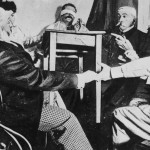 spirit mediums of the day. We can argue as to whether any spirits were ever actually contacted, but thanks to the efforts of Harry Houdini, Arthur Conan Doyle, and others, the vast majority of mediums were unmasked as theatrical frauds. Unscrupulous though they may have been, most were undeniably talented in their subterfuge. Sleight-of-hand, secret accomplices, and crucially, opportunistic use of pitch-black dark, were all the tools-in-trade of the spirit medium. These tools would also prove crucial to the generations of performers to follow.
spirit mediums of the day. We can argue as to whether any spirits were ever actually contacted, but thanks to the efforts of Harry Houdini, Arthur Conan Doyle, and others, the vast majority of mediums were unmasked as theatrical frauds. Unscrupulous though they may have been, most were undeniably talented in their subterfuge. Sleight-of-hand, secret accomplices, and crucially, opportunistic use of pitch-black dark, were all the tools-in-trade of the spirit medium. These tools would also prove crucial to the generations of performers to follow.
Next came the vaudevillians of the twenties—stage magicians who’d learned their craft from the spirit mediums, or perhaps had been spirit mediums themselves. The switch was subtle but telling; they now had an audience who were not looking for true mysticism, but were rather looking to be tricked. Expecting it.
The stage magician never went away, of course, but as the shows evolved, became more grandiose, a few spun off into creating a more easily staged, more pedestrian type of show. It was the Spook Show, or the ghost show—traveling live performances staged at small-town theaters and school auditoriums all across the country.
They came in almost like the circus: silk-screened handbills would appear all over town, promising impossible frights, supernatural appearances, and almost 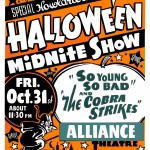 always, beautiful girls who would be “sacrificed” to the spooks, right before your unbelieving eyes. This was during the heyday of the Cinemascope movie monsters, so there were sure to be (probably unlicensed) perfomances by Dracula, the Wolfman, the Mummy, and Frankenstein’s Monster. The girls would be plants, hired from local modeling agencies, and chosen both for their physical attractiveness and their ability to let loose a bloodcurdling scream.
always, beautiful girls who would be “sacrificed” to the spooks, right before your unbelieving eyes. This was during the heyday of the Cinemascope movie monsters, so there were sure to be (probably unlicensed) perfomances by Dracula, the Wolfman, the Mummy, and Frankenstein’s Monster. The girls would be plants, hired from local modeling agencies, and chosen both for their physical attractiveness and their ability to let loose a bloodcurdling scream.
Much was promised in these shows. I’ve heard old recordings of radio ads, which vowed oceans of blood and nonstop heart-stopping frights. A bit less was delivered. Where the promoter would promise that every girl in attendance would be kidnipped by rampaging monsters, one or two models would be carried off by an actor in a mask. By and large the audiences were okay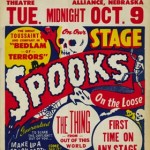 with this. Like the vaudeville audiences that preceded them, they were expecting a show. As long as the entertainment was there, then outsized promises would be forgiven.
with this. Like the vaudeville audiences that preceded them, they were expecting a show. As long as the entertainment was there, then outsized promises would be forgiven.
The entertainment consisted of, in addition to the rubber-faced monsters and the screaming girls, rather cheap tricks. Luminous paint, fishing line, and toy snakes were indispensible. With these they could make the show a personal experience for everyone there. The snakes would be tossed into the audience by unseen hands, often accompanied by recorded screams or a shouted 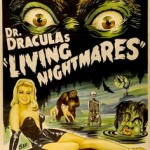 desperate cry that “The snakes have gotten loose! They’re in the audience! They’re biting people!” Other plants would hide in the balcony and handle fishing rods, sometimes causing luminous-painted “ghosts” to fly about the theater, sometimes just eerily brushing the faces of audience members with thin filament, while the barker onstage insisted that the spooks were here, and they’re touching you.
desperate cry that “The snakes have gotten loose! They’re in the audience! They’re biting people!” Other plants would hide in the balcony and handle fishing rods, sometimes causing luminous-painted “ghosts” to fly about the theater, sometimes just eerily brushing the faces of audience members with thin filament, while the barker onstage insisted that the spooks were here, and they’re touching you.
So why is the Spook Show gone, and why won’t it come back? That DVD commentary I mentioned blamed it on TV, on the evolution of entertainment, and on a new, more sophisticated audience. Spook Show pioneer Jim “The Mad Doctor” Ridenour said, “An audience would probably burn down the theater if someone tried to scare them with a rubber snake, a luminscent spook, or the good old Frankenstein Monster.”
I’m not so sure. Theatrical haunted houses are insanely popular this time of year (I keep asking my five-year-old daughter if she’s ready for one. She says no). That type of schtick-fright is only a bit removed from the Spook Show methods of yesteryear. Audiences as always simply want entertainment. If they get one good scare, then laugh at themselves because it was a cheesy scare, I think they’d be okay with that.
 But no, the Spook Show is gone, forever, for a much simpler reason: the exit light. The Spook Show could only function when it could create, at will, a pitch-dark theater, so that the luminous paint and creeping black-clad stagehands could do their work. Theaters then weren’t required to have the lighted exit signs, or the always-on floor lights, so the gags worked. They wouldn’t today.
But no, the Spook Show is gone, forever, for a much simpler reason: the exit light. The Spook Show could only function when it could create, at will, a pitch-dark theater, so that the luminous paint and creeping black-clad stagehands could do their work. Theaters then weren’t required to have the lighted exit signs, or the always-on floor lights, so the gags worked. They wouldn’t today.
And more’s the pity, because that means we’ll never see anything like the Spook Show again. The best we can do (and maybe even this becomes more impossible with the passing of years) —is to remember that once upon a time, the Spooks came alive, right in your hometown theater.